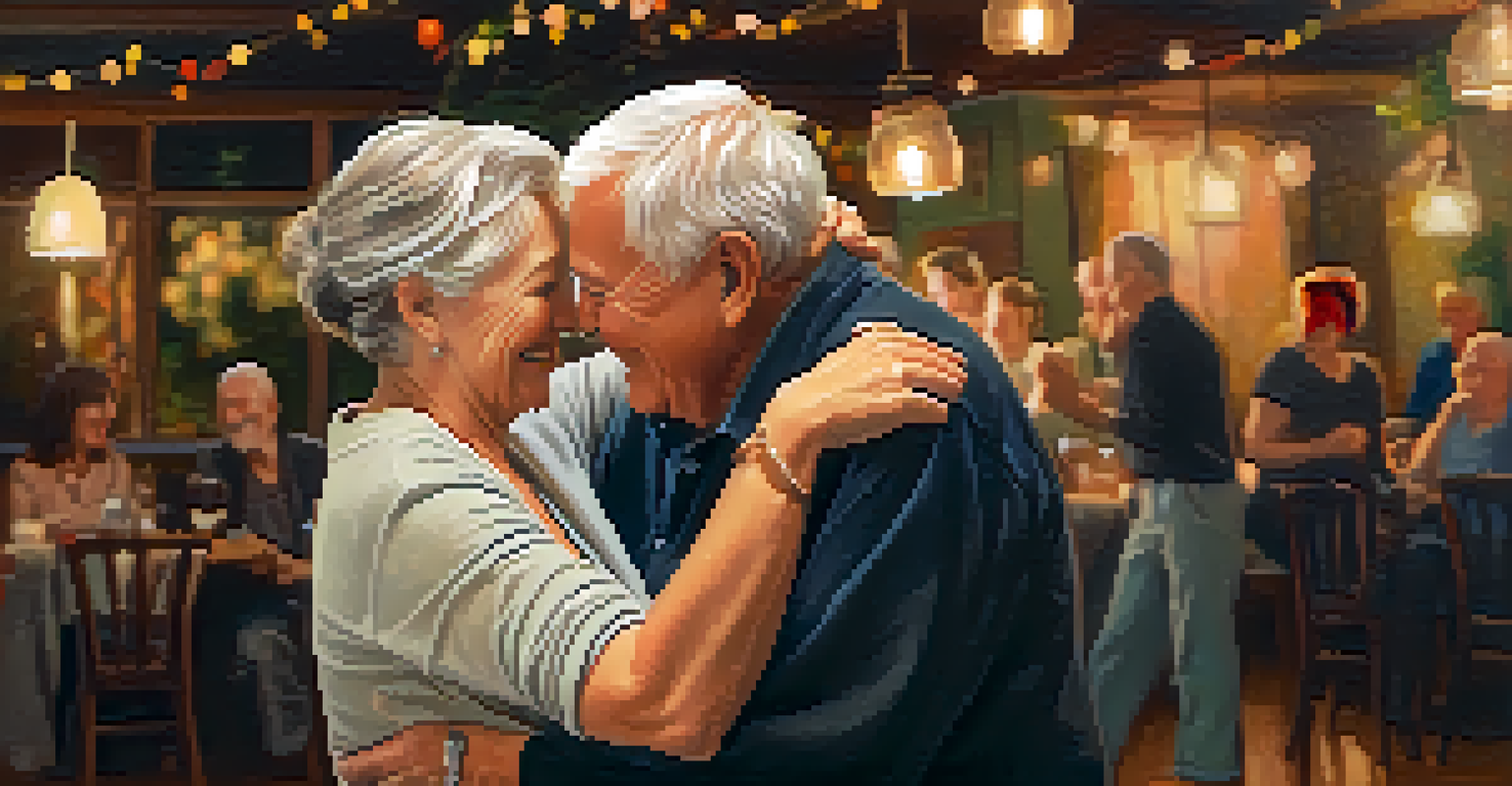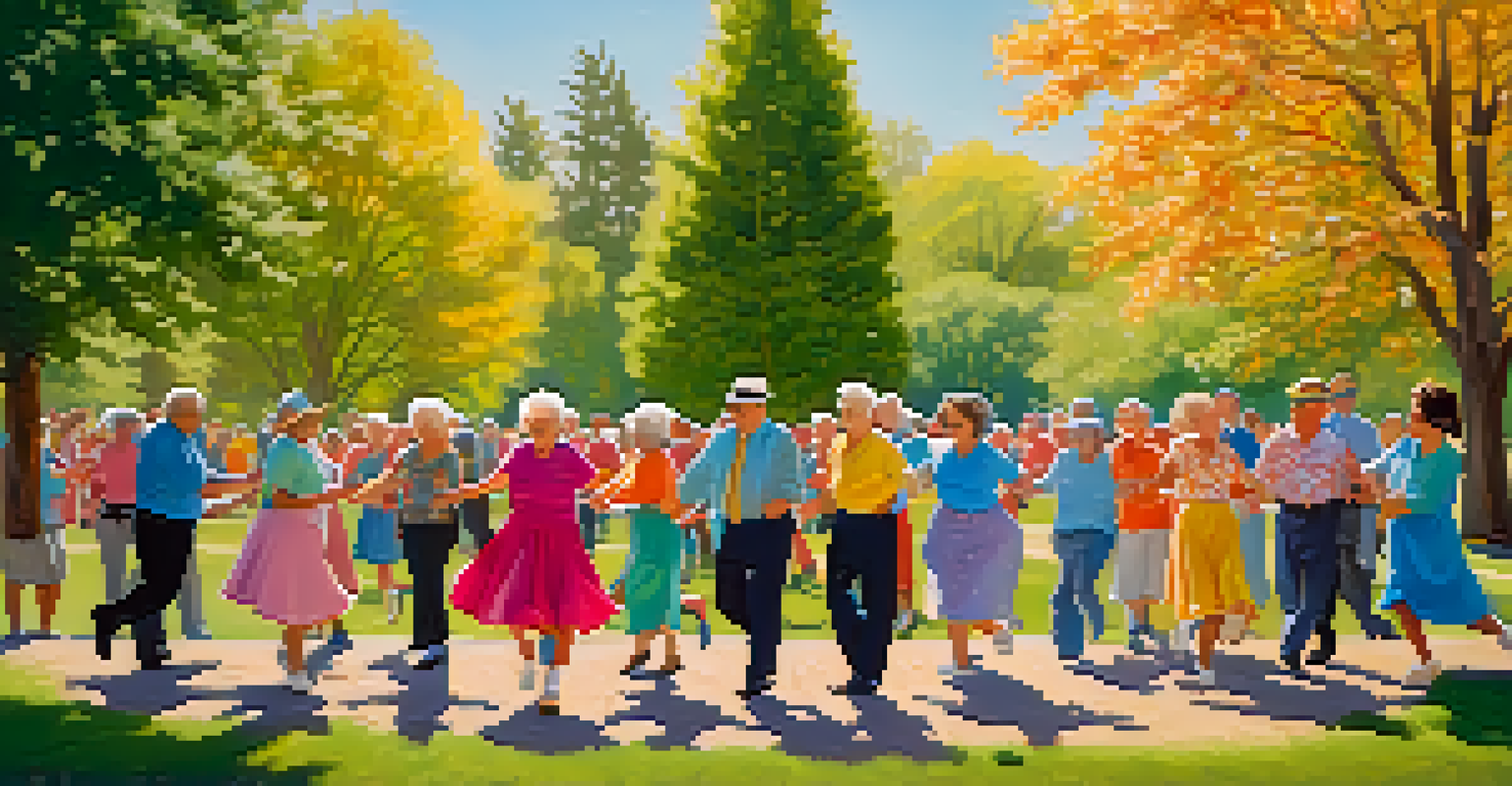Benefits of Group Dance Classes for Older Adults' Health

Boosting Physical Fitness Through Dance
Group dance classes are a fun and dynamic way for older adults to improve their physical fitness. The rhythmic movements involved in dance can enhance cardiovascular health, build strength, and increase flexibility. Engaging in dance routines often feels less like a workout and more like a celebration, making it easier to commit to regular exercise.
Dance is the hidden language of the soul.
As participants move to the music, they work various muscle groups, which can help improve balance and coordination. This is particularly important for older adults, as maintaining balance can prevent falls—a significant risk for this age group. Plus, the social aspect of dancing encourages participants to keep coming back, leading to consistent physical activity.
Incorporating dance into a routine not only keeps the body active but can also lead to weight management and increased energy levels. Over time, many dancers find themselves feeling revitalized and more capable of handling daily tasks, all while having a great time with friends.
Enhancing Mental Well-being Through Community
Group dance classes provide a wonderful opportunity for older adults to connect with others, fostering a sense of community and belonging. Social interaction is crucial for mental health, especially for seniors who may experience loneliness or isolation. Dancing alongside others creates bonds and friendships that enhance emotional well-being.

Moreover, engaging in dance requires focus and concentration, which can boost cognitive function. Learning new steps and routines challenges the brain, keeping it active and engaged. This mental stimulation is essential in combating age-related cognitive decline and may even reduce the risk of conditions like dementia.
Dance Boosts Physical Fitness
Group dance classes enhance cardiovascular health, strength, and flexibility while making exercise enjoyable.
The joy of dancing, combined with social interaction, releases endorphins—often referred to as 'feel-good' hormones. This natural high can lead to improved mood and reduced symptoms of anxiety and depression, making group dance classes a holistic approach to mental health.
Building Confidence and Self-esteem
Participating in group dance classes can significantly enhance an individual's confidence and self-esteem. As older adults learn new dance styles and master new skills, they often experience a sense of accomplishment that boosts their self-worth. This newfound confidence can translate into other areas of life, encouraging individuals to try new activities or socialize more.
The dance is a poem of which each movement is a word.
Moreover, group dance classes provide a supportive environment where everyone encourages each other. This camaraderie fosters a positive atmosphere, allowing participants to feel accepted and valued regardless of their skill level. Celebrating each other's successes, no matter how small, builds a sense of community that uplifts everyone's spirits.
As older adults gain confidence in their dancing abilities, they may also become more willing to express themselves creatively. This self-expression can be liberating and therapeutic, further enhancing their overall sense of identity and joy in life.
Improving Coordination and Balance Skills
Group dance classes naturally enhance coordination and balance, essential skills for older adults. Many dance forms, whether it be ballroom, salsa, or line dancing, require participants to move in rhythm while controlling their body movements. This practice helps improve motor skills and stabilizes posture.
Regularly practicing dance routines can significantly reduce the risk of falls, which are a common concern as people age. The movements practiced in dance classes engage core muscles, which play a vital role in maintaining stability and balance. Stronger core muscles lead to better balance, making everyday activities easier and safer.
Fosters Community and Connection
Engaging in dance promotes social interaction, reducing feelings of loneliness and enhancing emotional well-being.
Additionally, dance encourages body awareness—understanding how one's body moves in space. This heightened awareness can contribute to overall physical confidence, allowing older adults to navigate their environments more effectively and with less fear of falling.
Promoting Cardiovascular Health
One of the most significant benefits of group dance classes for older adults is the promotion of cardiovascular health. Dancing is an excellent aerobic exercise that gets the heart rate up, improving circulation and heart function. Regular participation can lead to lower blood pressure and a reduced risk of heart disease.
The varied rhythms and styles in dance provide a great way to keep the body moving without the monotony that can come with traditional exercise. This variety keeps older adults engaged, making it easier to stick to a routine that benefits cardiovascular health. Plus, dancing is adaptable; individuals can choose the intensity that suits their fitness level.
Engaging in dance not only strengthens the heart but also boosts stamina. As older adults dance regularly, they may find themselves feeling more energetic and capable of handling daily tasks without becoming fatigued, which is a significant quality of life improvement.
Encouraging Lifelong Learning and Adaptability
Group dance classes are fantastic for encouraging lifelong learning, as they often introduce new styles and techniques. For older adults, the chance to learn something new can be invigorating and fulfilling. This pursuit of knowledge keeps the mind sharp and encourages a positive outlook on aging.
Moreover, adapting to different dance styles cultivates flexibility—both physically and mentally. As older adults learn to switch between various styles, they develop the ability to adapt to new situations in everyday life. This adaptability can lead to increased resilience and an overall more positive attitude.
Builds Confidence and Resilience
Learning new dance skills in a supportive environment boosts self-esteem and encourages creative self-expression.
By embracing the learning process inherent in dance, older adults can maintain a curious mindset. This curiosity can open doors to new friendships, experiences, and opportunities that enrich their lives.
Creating Joy and Lifelong Memories
Dance is inherently joyful, and group dance classes create an atmosphere of fun and laughter. For older adults, the sheer joy of dancing can bring back fond memories of youth and create new, cherished experiences. This joy can be a powerful antidote to the challenges that come with aging.
The shared experiences in dance classes often lead to memorable moments. Whether it's mastering a new routine or simply enjoying a laugh after a misstep, these moments foster strong bonds among participants. These memories contribute to a rich tapestry of life that older adults can reflect upon with warmth.

Moreover, the joy derived from dancing can have lasting effects on mental health. A positive mindset nurtured through dance can lead to greater overall satisfaction with life, encouraging older adults to seek out more joyful experiences beyond the dance floor.